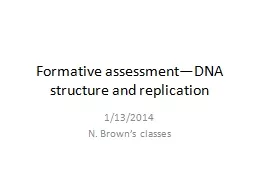

1132014 N Browns classes 1 Every nucleotide is made up of Sugar Phosphate Nitrogen base All of the above 1 Every nucleotide monomer is made up of Ribose Sugar Phosphate Nitrogen base ID: 914921
Download Presentation The PPT/PDF document "Formative assessment—DNA structure and..." is the property of its rightful owner. Permission is granted to download and print the materials on this web site for personal, non-commercial use only, and to display it on your personal computer provided you do not modify the materials and that you retain all copyright notices contained in the materials. By downloading content from our website, you accept the terms of this agreement.
Slide1
Formative assessment—DNA structure and replication
1/13/2014
N. Brown’s classes
Slide21 Every
nucleotide is made up of…
Sugar
PhosphateNitrogen baseAll of the above
Slide31
Every nucleotide
monomer is
made up of…Ribose SugarPhosphate
Nitrogen baseAll of the above
In
ribonucleotides
of RNA, this C of the ribose is bonded to an H and to an OH group. In
deoxyribonucleotides
of DNA, this C shows 2 H bonded instead---
deoxy
-
means w/o an O!
Slide42 Regarding
the nitrogen bases, Adenine always bonds with which one?
Cytosine
ThymineGuanineUracil
Slide52 Regarding
the nitrogen bases,
in double stranded DNA, the nucleotide Adenine
always bonds with which one?CytosineThymine
GuanineUracil
Note the
antiparallel
(facing opposite directions) strands joined by complementary nitrogenous base pairs between the
deoxyribonucleotides
: A to T and C to G
Hydrogen bonds (H bonds) attract the nitrogenous base pairs to each other and hold the 2 strands of
Dna
together in the double helix
Slide6The 2 halves of the
DNA double helix
are comprised of H bonded complementary, but
anti-parallel, deoxyribonucleotide base pairs.
Slide73
DNA
contains the code to make what macromolecule?
GlucoseProteinCarbohydrates
Lipids
Slide83 DNA
contains the code to make what macromolecule?
Glucose
ProteinCarbohydrates
Lipids
Each gene contains the pattern for a particular protein (the order in which to put amino acid monomers together to build the polymer called a protein.
Proteins are the tools that carry out all the jobs and build most of the structures in our cells.
Slide9expression (use) of genes to make proteins
Slide104 The
two strands of DNA are bonded together in the middle by their…
Sugars
Phosphates Nitrogen bases
Slide114
The two strands of DNA are bonded together in the middle by their…
Deoxyribose
SugarsPhosphates groups
Nitrogenous bases
H
hydrogen
bonds between the complementary base pairs
temporaily
join them the two strands—the Hydrogen bonds are broken to allow DNA replication or transcription when mRNA is made.
Slide125 What type of bonds are between the sugars and phosphates in DNA?
Hydrogen
Covalent
IonicMetallic
Slide135 What
type of bonds are between the sugars & phosphates in DNA?
Hydrogen
CovalentIonicMetallic
Strong permanent covalent bonds link sugars and phosphates into the sides (backbones) of the double helix
Slide146 If
one strand of DNA had a sequence of nitrogen bases that read A C
C
T G A , than the complementary strand would have what sequence?A C C T G AC T T G A T
T G G A C TT A A C C C
Slide156 If
one strand of DNA had a sequence of nitrogen bases that read A C
C
T G A , than the complementary strand is__?A C C T G AC T T G A T
T G G A C TT A A C C C
Slide167 In
the following DNA molecule which is the
Deoxyribose
Sugar12
34
1
2
3
4
Slide177 In
the following DNA molecule which is the
Deoxyribose
Sugar12
34
1
2
3
4
Slide188 The
letter A at the bottom of the picture represents this monomer unit?
Amino acid
Nucleotide
DNAmRNA
A
Slide198 The
letter A at the bottom of the picture represents this monomer unit?
Amino acid
Nucleotide
DNAmRNA
A
Slide209 If
a double stranded DNA molecule contains 28 sugars, how many
nucleotides
would your DNA ladder contain?114
284256
Slide219:
If a double stranded DNA molecule contains 28 sugars, how many
nucleotides
would your DNA ladder contain?114
284256
Slide2210 If
a particular strand of DNA contains 20% Adenine, what percentage of Thymine can be expected in the complementary strand of DNA?
1%
10%20%
40%80%
Slide2310 If
a particular strand of DNA contains 20% Adenine, what percentage of Thymine can be expected in the complementary strand of DNA?
1%
10%20%
40%80%
Slide2411 Which
one of the following nucleotide pair bonds would be found in a DNA molecule?
adenine-guanineguanine-cytosineadenine-cytosine
cytosine-uracil
Slide2511:
Which one of the following nucleotide pair bonds would be found in a DNA molecule?
adenine-guanineguanine-cytosineadenine-cytosine
cytosine-uracil
Slide2612 The
backbone of a DNA molecule is made of which two components?
phosphate molecules and ribose sugars
deoxyphosphate molecules and ribose sugars
phosphate molecules and deoxyribose sugarsdeoxyphosphate molecules and deoxyribose sugars
Slide2712:
The backbone of a DNA molecule is made of which two components?
phosphate molecules and ribose sugars
deoxyphosphate molecules and ribose sugars
phosphate molecules and deoxyribose sugarsdeoxyphosphate molecules and deoxyribose sugars
Slide2813 Watson
and Crick were the first to suggest that DNA is _____.
a short molecule
the shape of a double helixa protein molecule
the genetic material
Slide2913:
Watson and Crick were the first to suggest that DNA is _____.
a short molecule
the shape of a double helixa protein molecule
the genetic material
Slide30Where does DNA replication take place in a cell?
Cytoplasm
Endoplasmic Reticulum
Golgi BodyNucleus
Vacuole
Slide3114:
Where does DNA replication take place in a cell?
Cytoplasm
Endoplasmic Reticulum
Golgi BodyNucleusVacuole
Slide3215 DNA
is a
Carbohydrate
Protein
Nucleic Acid
Lipid
Slide3315:
DNA is a
Carbohydrate
ProteinNucleic Acid
Lipid
Slide3416 The
monomer units of DNA are called
Deoxyribose
Nucleotides
Adenines
Ribose
Slide3516 The
monomer units of DNA are called
Deoxyribose
Nucleotides
Adenines
Ribose